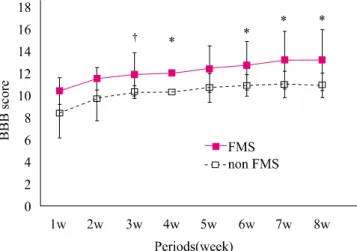기능적 자기자극치료 효과
The Journal Korean Society of Physical Therapy
■
조윤우, 김수정
1, 박해운
2, 서정민
3, 황세진
4, 장성호, 이동규, 안상호
■
영남대학교 의과대학 재활의학교실,
1영남대학교 의과학연구소,
2대구카톨릭대학교 의과대학 재활의학교실,
3영남대학교 의료공학연구소,
4한양대학교 의과대학 해부 및 세포생물학교실
The Effect of Direct Functional Magnetic Stimulation of the Lesion on Functional Motor Recovery in Spinal Cord Injured Rat
Yun‐Woo Cho, MD, PhD; Su‐Jeong Kim, PhD
1; Hea‐Woon Park, MD, PhD
2; Jeong‐Min Seo, MS
3; Se‐Jin Hwang, MD, PhD
4; Sung‐Ho Jang, MD; Dong‐Gyu Lee; Sang‐Ho Ahn, MD, PhD
Department of Rehabilitation Medicine, College of Medicine, Yeungnam University;
1Institute of Medical Science, Yeungnam University;
2Department of Rehabilitation Medicine, School of Medicine, Catholic University of Deagu;
3
